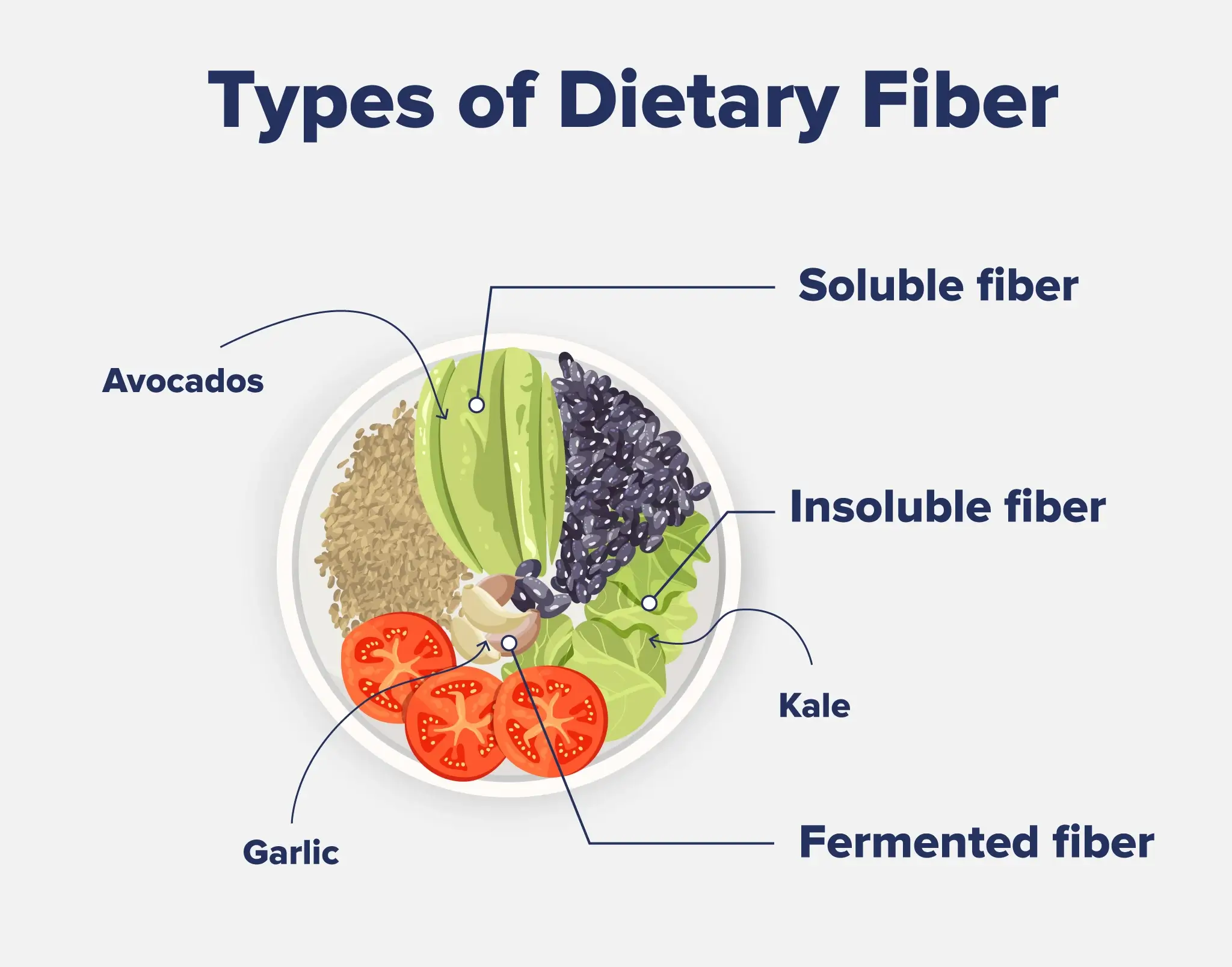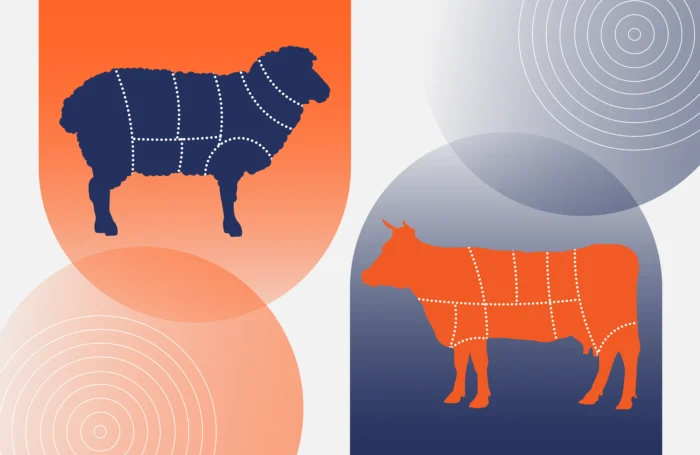This post contains links through which we may earn a small commission should you make a purchase from a brand. This in no way affects our ability to objectively critique the products and brands we review.
How Much Fiber Per Day Is Recommended?
Evidence Based Research To fulfill our commitment to bringing our audience accurate and insightful content, our expert writers and medical reviewers rely on carefully curated research.
Read Our Editorial Policy
Evoking images of older adults and Metamucil powder, fiber is admittedly not the sexiest topic in the nutrition world—but maybe it’s time to revamp that narrative.
With benefits going far beyond digestion—including heart health, blood sugar regulation, weight management, and even immune function and cognition—fiber deserves more credit than it gets.1
But how much do we really need to eat of it per day? In this article, find out how much dietary fiber is recommended by age group, the different types of fiber, and where to find it.
End the Bloat Saga
Map your microbiome triggers and eat without fear.
End the Bloat Saga
Map your microbiome triggers and eat without fear.

How Much Fiber Per Day?
First things first: what is fiber, exactly?
Fiber is a non-digestible carbohydrate found in plants. Since it is not digested or absorbed, it passes through the gastrointestinal tract intact, helping food and waste move through our system and benefiting our health.2
The USDA Dietary Guidelines for Americans (DGA) recommend that adult women eat 22-28 grams of fiber per day and men consume 28-34 grams.3
However, it differs quite a bit by age group and sex:
| Population | Recommended Grams of Fiber Per Day |
| Children age 2-3 | 14g |
| Girls age 4-8 | 17g |
| Boys age 4-8 | 20g |
| Girls age 9-13 | 22g |
| Boys age 9-13 | 25g |
| Girls age 14-18 | 25g |
| Boys age 14-18 | 31g |
| Women age 19-30 | 28g |
| Men age 19-30 | 34g |
| Women age 31-50 | 25g |
| Men age 31-50 | 31g |
| Women age 51+ | 22g |
| Men age 51+ | 28g |
Another similar recommendation from the Academy of Nutrition and Dietetics is to consume 14 grams of dietary fiber per 1,000 calories. For example, someone eating a 2,000-calorie diet should aim for 28 grams of fiber daily.4
Unfortunately, most people don’t get anywhere near enough fiber from the food they eat.
According to the 2020-2025 Dietary Guidelines for Americans, 90 percent of women and 97 percent of men do not meet the recommended dietary fiber intake.3
What Are the Types of Fiber?
There are two primary types of fiber: soluble and insoluble.
As the name suggests, soluble fiber dissolves in water, forming a gel-like substance in your digestive system. This slows down digestion, which is beneficial for preventing blood glucose spikes after eating and boosting satiety.2
Soluble fiber is also known to help lower your total blood cholesterol levels, improve blood sugar levels, and reduce insulin resistance.5
High-fiber foods that primarily contain soluble fiber include oat bran, barley, nuts, seeds, beans, lentils, peas, psyllium husk, apples, carrots, citrus fruits, avocados, pears, and berries.
Insoluble fiber doesn’t dissolve in water, remaining intact as it passes through your digestive system. This helps “move things along,” clearing out waste and facilitating healthy bowel movements.2
Foods rich in insoluble fiber are whole-wheat flour, wheat bran, nuts, beans, potatoes, quinoa, brown rice, legumes, kale, almonds, walnuts, and some seeds, like sesame.
Fruits and vegetables are generally higher in soluble fiber, while whole grains are richer in insoluble fiber. However, many foods contain both—for example, the peel or outer skin of fruit often contains insoluble fiber, while the inner portions are soluble.
Another sub-type of fiber is fermentable fiber, which can come from either of the previous two categories, although it is more often in soluble fiber. Fermented fiber—also known as prebiotic fiber—acts as fuel for your healthy gut bacteria to consume and thrive on.6
You can find prebiotic fiber in garlic, leeks, onions, less-ripe bananas, oats, whole wheat bran, barley, chicory, asparagus, Jerusalem artichokes, and cooked-then-cooled potatoes.

How to Increase Fiber Intake
If you are one of the typical Americans who only consume 12 grams of fiber daily or less, it’s best not to drastically change your fiber consumption overnight.
A huge bump in fiber intake will almost certainly cause digestive problems like gas, bloating, and diarrhea, as your current gut microbiome is not equipped to handle the increased amounts of fiber passing through.
To comfortably increase your fiber intake, don’t attempt to boost it by more than 5 grams per day. If you don’t have much fiber in your diet now, increasing by 2 to 3 grams per day is ideal, slowly working your way up to the recommended amount for your age and sex.
You can increase your fiber intake slowly without changing too much about your diet—here are some tips:
- Swap white flour products or white rice for their whole-grain counterparts (i.e., switch your white pasta to whole-wheat or legume-based pasta, and swap white bread for whole-wheat bread)
- Swap fruit juice for whole fruits
- Add raspberries to your breakfast
- Choose bread with 5 grams of fiber per slice or more
- Sprinkle oat bran, flax seed, or wheat germ over oatmeal, yogurt, or cereal
- Opt for high-fiber cereal
- Add beans to your salads (garbanzo beans and kidney beans are great options)
Some of the highest-fiber foods to add to your diet include:
- Split peas
- Lentils
- Black beans
- Cannelini beans
- Chia seeds
- Raspberries
- Artichokes
- Pears
- Kiwi
- Kale
- Green peas
- Broccoli
- Barley
- Bran flakes
- Quinoa
- Oatmeal
If you start to increase the amount of fiber in your diet, remember to monitor your water intake. Eating lots of fiber without enough hydration means the soluble fiber won’t absorb water, leading to constipation. Fiber plus water makes for bulkier stools that are easier to eliminate.7

Fiber Supplements
As with most supplements, it’s typically better to get dietary fiber from whole food sources. That said, if you have a lot of trouble eating high-fiber foods or want to bolster your daily intake, fiber supplements can help to bridge the gap—as long as you don’t entirely rely on them.
Fiber-rich foods like fruits, vegetables, beans, legumes, and whole grains also contain beneficial vitamins, minerals, antioxidants, and phytonutrients that most fiber supplements simply don’t have.
It’s also more likely that you consume too much fiber when eating it in supplemental form, which can cause digestive problems. Conversely, you’d have a hard time eating an excessive amount of fiber from whole foods.
In a paper published in Nutrition Today, Johnson W. McRorie, Jr, PhD, FACG, AGAF, FACN concludes, “Fiber supplements cannot be presumed to provide the health benefits that are associated with dietary fiber from whole foods. Of the fiber supplements on the market today, only a minority possess the physical characteristics that underlie the mechanisms driving clinically meaningful health benefits.” 8
Dr. McRorie states that the only type of fiber supplement that has been clinically proven to provide all of the same health benefits is a soluble, non-fermenting, gel-forming fiber—essentially, psyllium husk.8
While some other types of supplemental fiber have been found to do one thing or another (i.e., just help with constipation or lower cholesterol), psyllium husk has shown promise for lowering cholesterol, improving blood sugar control, increasing satiety, helping with weight loss, softening stool, and helping with IBS (irritable bowel syndrome).8
Fiber FAQs
What is fiber good for?
The potential benefits of dietary fiber include:2
• Promotes digestive health, including reducing the risk of constipation or diarrhea
• Reduces gut dysbiosis and supports a healthy gut microbiome
• Reduces the risk of colorectal and breast cancer
• May help with weight loss
• Lowers unhealthy cholesterol and blood sugar levels
• Reduces the risk of cardiovascular disease and type 2 diabetes
• Linked to a reduced risk of depression
Why do men have higher fiber recommendations than women?
Men have a higher recommended intake of most nutrients, including fiber. The primary reason is that, in general, men tend to be larger than women and, therefore, require more nutrients. Regarding fiber specifically, one speculation is that men require more because of their increased rates of heart disease compared to women, and fiber is known to help reduce the risk of cardiovascular disease and stroke.9 One study of almost 60,000 Japanese adults found that men who consumed the highest amount of total dietary fiber had a 19% reduced risk of coronary heart disease compared to those who consumed the least. The results for eating insoluble fiber were even more impressive: men eating the most had a 52% reduced risk of CHD compared to those eating the least.10
Are fiber supplements as good as food?
As with most supplements, it’s typically better to get dietary fiber from whole foods sources. That said, if you have a lot of trouble eating fiber-rich foods or want to bolster your daily intake, fiber supplements can help to bridge the gap—as long as you don’t completely rely on them. Fiber-rich foods like fruits, vegetables, beans, legumes, and whole grains also contain beneficial vitamins, minerals, antioxidants, and phytonutrients that fiber supplements simply don’t have. Psyllium husk may be the most comprehensive fiber supplement, providing benefits to heart health, digestion, weight loss, and blood sugar control.
What food is highest in fiber?
Beans and legumes have the greatest amount of dietary fiber when considering typical serving sizes. For example, 1 cup of cooked split peas contains 16g of fiber per cup, 1 cup of cooked lentils contains 15.6g, and 1 cup of black beans contains 15.4g per cup. The highest-fiber fruit is raspberries, at 8 grams per cup, and the highest-fiber vegetables are artichokes, with 9.6 grams per cup.
How much fiber should you eat to lose weight?
Eating the recommended amount of fiber for your sex and age group is an excellent place to start for weight loss—approximately 25 grams per day for women and 35 grams per day for men. Some research has shown that eating an extra 14 grams of fiber per day is linked to a 10% decrease in overall calorie intake and additional body weight loss of 4.18 pounds over 3.8 months.11
Is 50 grams of fiber too much?
While there is technically no daily upper limit for dietary fiber intake, consuming large amounts of fiber will probably cause digestive problems. This is especially true for fiber supplements, which are isolated from their natural food source and are easier to consume in large doses.
While 50 grams of fiber might be beneficial, not everyone needs that much. Plus, you should be careful if you don’t already consume adequate amounts of fiber. If you currently eat only 10 grams daily, bumping up to 50 grams overnight will cause serious digestive distress. Increasing your fiber intake by more than 5 grams per day is typically not recommended.
What are the symptoms of too much fiber?
Signs of eating too much fiber are usually digestive-related, including gas, bloating, constipation, diarrhea, nausea, and cramping. Excess fiber may also reduce the body’s ability to absorb essential minerals (calcium, zinc, and iron) because the fiber binds with minerals and removes them in the stool. In rare cases, too much fiber can cause intestinal blockage.
- Anderson, J. W., Baird, P., Davis, R. H., Jr, Ferreri, S., Knudtson, M., Koraym, A., Waters, V., & Williams, C. L. (2009). Health benefits of dietary fiber. Nutrition reviews, 67(4), 188–205. https://doi.org/10.1111/j.1753-4887.2009.00189.x
- Barber, T. M., Kabisch, S., Pfeiffer, A. F. H., & Weickert, M. O. (2020). The Health Benefits of Dietary Fibre. Nutrients, 12(10), 3209. https://doi.org/10.3390/nu12103209
- U.S. Department of Agriculture and U.S. Department of Health and Human Services. Dietary Guidelines for Americans, 2020-2025. 9th Edition. December 2020. Accessed at https://www.dietaryguidelines.gov/sites/default/files/2021-03/Dietary_Guidelines_for_Americans-2020-2025.pdf
- Dahl, W. J., & Stewart, M. L. (2015). Position of the Academy of Nutrition and Dietetics: Health Implications of Dietary Fiber. Journal of the Academy of Nutrition and Dietetics, 115(11), 1861–1870. https://doi.org/10.1016/j.jand.2015.09.003
- Erkkilä, A. T., & Lichtenstein, A. H. (2006). Fiber and cardiovascular disease risk: how strong is the evidence?. The Journal of cardiovascular nursing, 21(1), 3–8. https://doi.org/10.1097/00005082-200601000-00003
- Carlson, J. L., Erickson, J. M., Lloyd, B. B., & Slavin, J. L. (2018). Health Effects and Sources of Prebiotic Dietary Fiber. Current developments in nutrition, 2(3), nzy005. https://doi.org/10.1093/cdn/nzy005
- Anti, M., Pignataro, G., Armuzzi, A., Valenti, A., Iascone, E., Marmo, R., Lamazza, A., Pretaroli, A. R., Pace, V., Leo, P., Castelli, A., & Gasbarrini, G. (1998). Water supplementation enhances the effect of high-fiber diet on stool frequency and laxative consumption in adult patients with functional constipation. Hepato-gastroenterology, 45(21), 727–732.
- McRorie J. W., Jr (2015). Evidence-Based Approach to Fiber Supplements and Clinically Meaningful Health Benefits, Part 1: What to Look for and How to Recommend an Effective Fiber Therapy. Nutrition today, 50(2), 82–89. https://doi.org/10.1097/NT.0000000000000082
- McRae M. P. (2017). Dietary Fiber Is Beneficial for the Prevention of Cardiovascular Disease: An Umbrella Review of Meta-analyses. Journal of chiropractic medicine, 16(4), 289–299. https://doi.org/10.1016/j.jcm.2017.05.005
- Eshak, E. S., Iso, H., Date, C., Kikuchi, S., Watanabe, Y., Wada, Y., Wakai, K., Tamakoshi, A., & JACC Study Group (2010). Dietary fiber intake is associated with reduced risk of mortality from cardiovascular disease among Japanese men and women. The Journal of nutrition, 140(8), 1445–1453. https://doi.org/10.3945/jn.110.122358
- Howarth, N. C., Saltzman, E., & Roberts, S. B. (2001). Dietary fiber and weight regulation. Nutrition reviews, 59(5), 129–139. https://doi.org/10.1111/j.1753-4887.2001.tb07001.x








